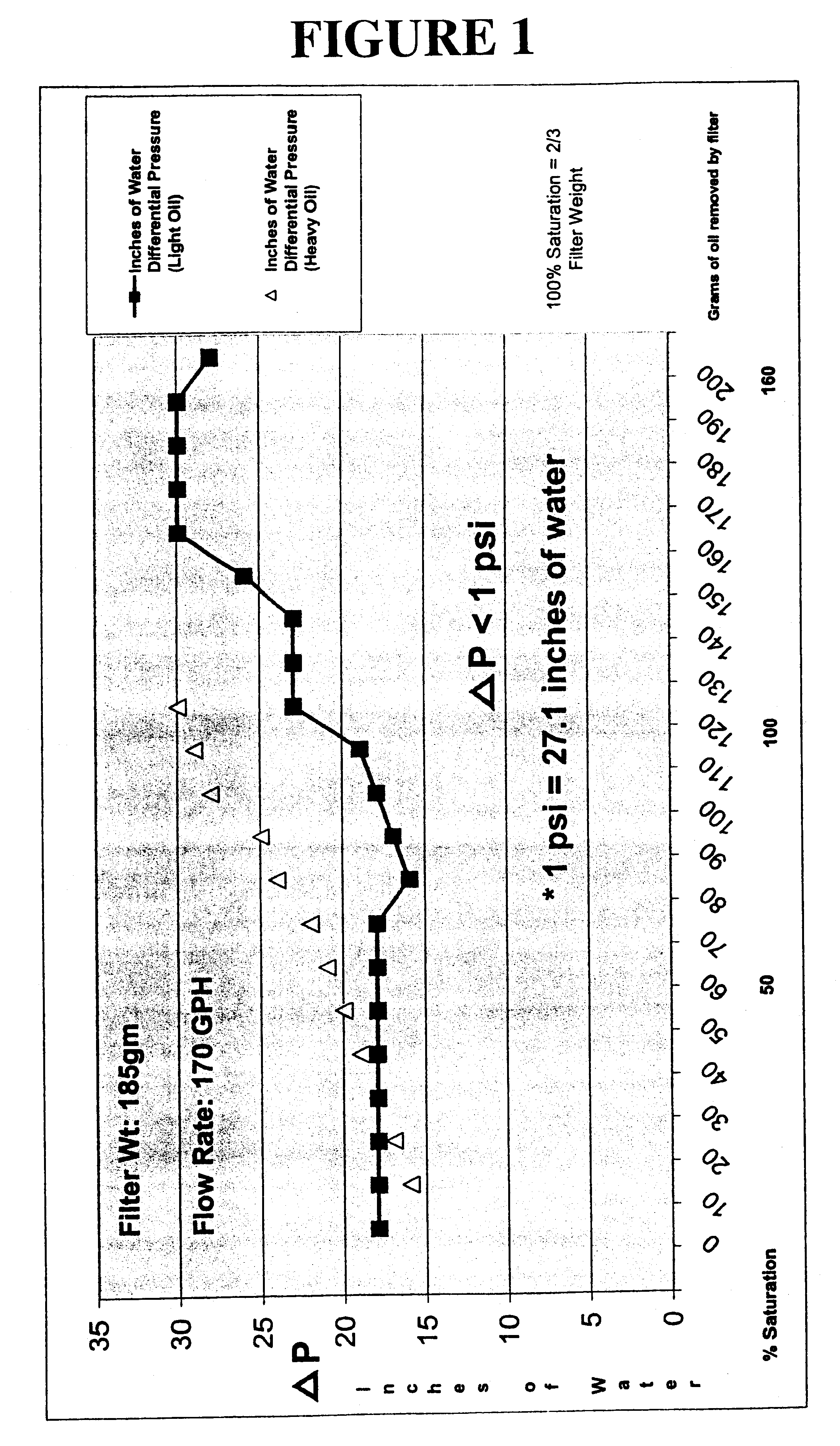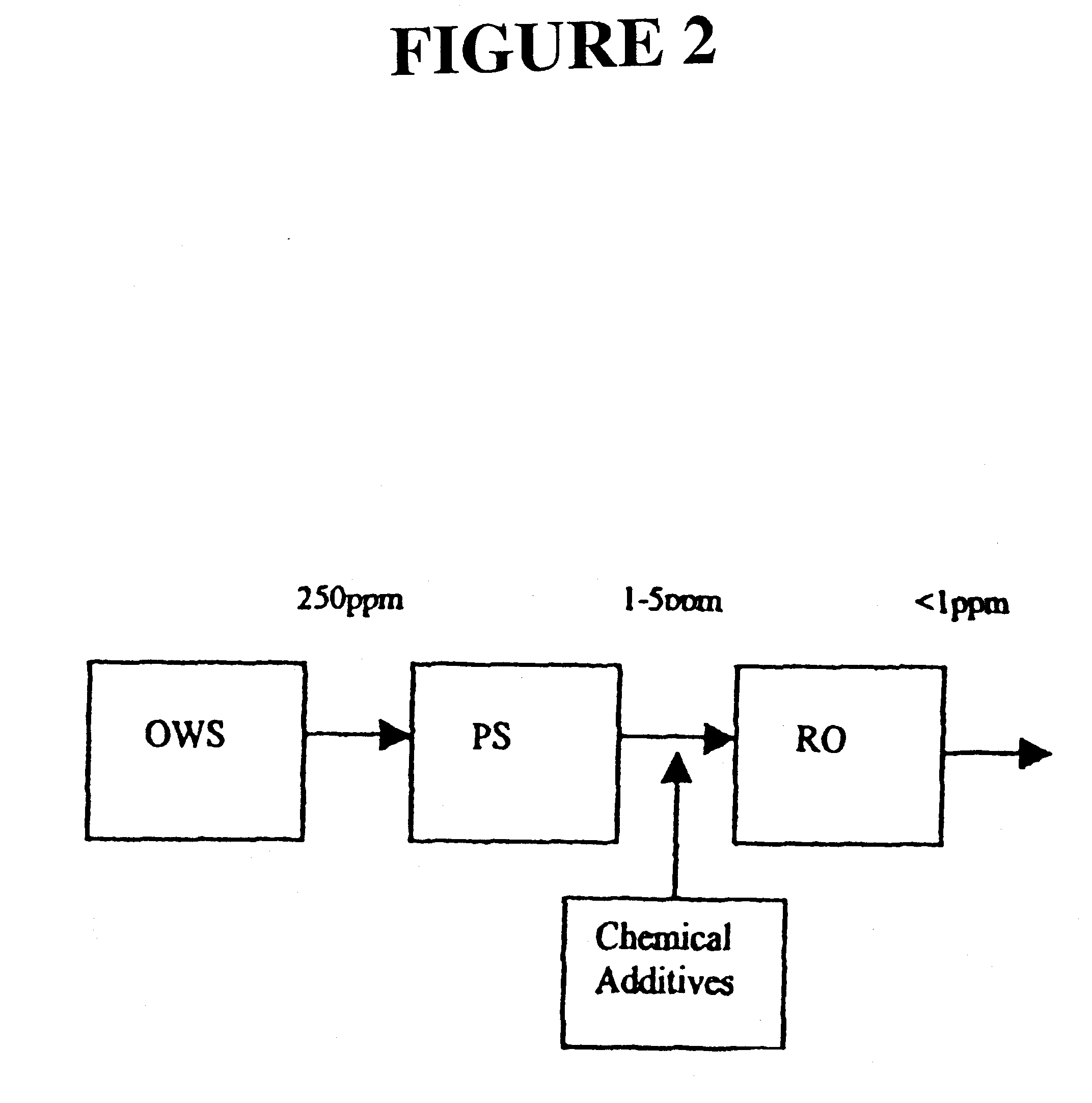Protection of crossflow membranes from organic fouling
a cross-flow membrane and organic technology, applied in the direction of filtration separation, separation process, treatment water, etc., can solve the problems of increasing the number of clogging, and forming stable and pseudo-stable oily emulsions, etc., to reduce or eliminate the known tendency of such membranes, the effect of increasing scaling
- Summary
- Abstract
- Description
- Claims
- Application Information
AI Technical Summary
Benefits of technology
Problems solved by technology
Method used
Image
Examples
example 1
In order to prepare a PST filter substrate for use with the invention, an infusion solution is prepared from a suitable solvent and the absorbent composition. In this example a solution was prepared from 90 w / w 99.9% acetone and 10 w / w absorbent composition which is the reaction product of 31% isobutyl methacrylate, 31% ELVACITE 2045, and 66% linseed oil. The absorbent composition is added to a closed explosion-proof mixer with the acetone and mixed for 12 hours or until the solution becomes homogeneous. The substrate in this Example was a nonwoven polypropylene, viz. the VERASPUN material of Yarorough & Co., Inc. of High Point NC. This material has a weight of 1 oz. / square ft. The substrate material was immersed in the infusion solution until saturated, then removed and excess liquid allowed to drip off. The material was then placed in a convection oven at 110 to 120.degree. F. until acetone free. The material was then cured at room temperature for one week. The resulting material ...
example 2
A wastewater sample deemed to be representative of a typical bilgewater and containing a large variety of contaminants was subjected to filtration using devices and methods in accordance with the present invention. The Serfilco cartridge unit utilized in the test holds 12 Amtek 10" spunbound polypropylene filters (Ametek, Inc., Sheboygan, Wis. 53082) in a parallel arrangement. Each filter element had been infused with about 17% by weight of the absorbent composition of the invention, by the procedure described in Example 1. A sample was processed in a single pass through the filter assembly. Flow rate through the filter was approximately 30 gpm, with dwell time in the filter assembly being 1 to 2 seconds. The contaminant concentrations for the input and output sample was measured and are shown in Table 1 below. It will be evident that outstanding removal of both organic contaminants and inorganic pernicious metallic ions has been achieved.
example 3
Filter Test Results
Effectiveness of the treated filter material of Example 1 is illustrated as a selective oil and organic chemical filter. The identity of these samples and the procedure are as follows:
Procedure: 750 g. of deionized water (20 megaohm) spiked with quantity sufficient dopant to achieve desired initial concentrations was passed through a tube of shredded polypropylene(VERASPUN) material 1 (weight=40 g) at a rate of about 0.5 L / minute with approximate contact time of 1.5 sec. The entire 750 ml was processed through the filter material and collected. A 50 ml sample of each effluent was drawn and analyzed using the standard EPA method for total organic carbon.
Conditions: contact time=1.5 sec. Filter wt=40 gm Effluent wt=750 gm
As can be seen, even with a massive amount of contamination, the purification factor ranges from 50.times. to 500.times. even though the dwell time was short and the weight of water processed exceeded the filter weight by 20.times.. There was notice...
PUM
| Property | Measurement | Unit |
|---|---|---|
| size | aaaaa | aaaaa |
| temperature | aaaaa | aaaaa |
| reaction temperatures | aaaaa | aaaaa |
Abstract
Description
Claims
Application Information
 Login to View More
Login to View More - R&D
- Intellectual Property
- Life Sciences
- Materials
- Tech Scout
- Unparalleled Data Quality
- Higher Quality Content
- 60% Fewer Hallucinations
Browse by: Latest US Patents, China's latest patents, Technical Efficacy Thesaurus, Application Domain, Technology Topic, Popular Technical Reports.
© 2025 PatSnap. All rights reserved.Legal|Privacy policy|Modern Slavery Act Transparency Statement|Sitemap|About US| Contact US: help@patsnap.com



